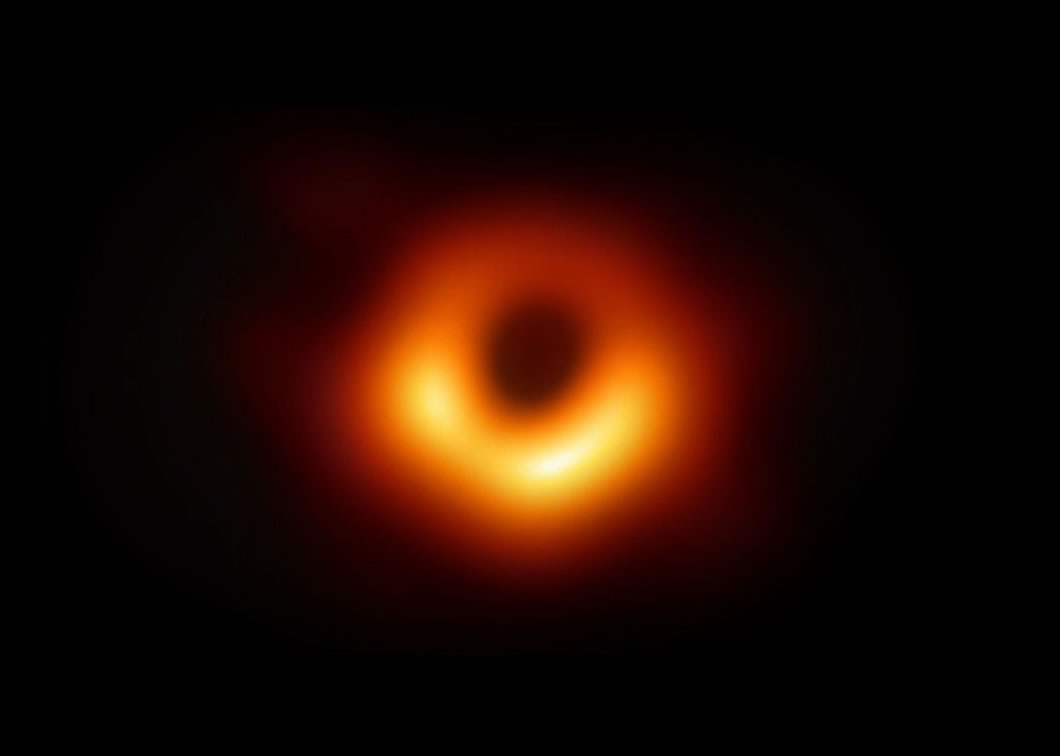College News
Curious About Black Holes? We Asked Our Physicists
On April 10, scientists released the first visual evidence of a supermassive black hole. The image, a result of international collaboration between scientists and eight separate telescopes collectively known as the Event Horizon Telescope, shows a blurry orange ring and— that’s all. “Sometimes seeing is believing but in this case not seeing is believing,” says professor of physics and dean emeritus Tom Helliwell. Of course, the dark space inside the orange ring is the black hole, which lurks some 55 million light-years away from Earth in the M87 galaxy. “The bright ring around the black hole is emitted by the matter orbiting the black hole, gradually drifting inward as it orbits, until it approaches the event horizon and subsequently vanishes from our view,” Helliwell says. “Evidence for black holes has been very strong for a long time now,” Helliwell says. “The picture is a graphical confirmation that black holes really do exist in the nuclei of galaxies. The first-ever picture of a black hole is very impressive. Einstein would have been amazed!” The editorial team received professional insight from Helliwell and other members of the Harvey Mudd physics community (see bit.ly/BHhmc19), and we asked our social media followers to submit their questions about the phenomenon. Harvey Mudd physics experts graciously replied.

Via Instagram, @captain_mom7 asks, What took us so long to get this picture? Why is this hard?
Mae Lee ’20, co-president of HMC’s Women in Physics Club, replies:
In short, this process took so long because of the pure volume of data that had to be processed. To get a full picture of the black hole, we would need a radio telescope as large as the entire earth! Instead of this, we have eight telescope locations that together make up the Event Horizon Telescope; they give us bits of the picture which we can feed through an algorithm that can piece together the rest of the image. Data was taken from these eight locations, collecting 64 gigabytes of data every second, which is around 1,000 times as fast as your standard home internet connection. This is too large to be transported over the internet, so it had to be physically transported (from all around the world to Massachusetts). In addition to transportation, that amount of data had to be fed through the algorithm, which also took a long time. These are just some of the reasons why it took so long to get this photo! (More of a visual learner? Lee has created a cartoon to explain this. See [web page])
@preet_h.i asks via Instagram, can the Hawking radiation theory be proved by the data collected? Thus, do black holes shrink over time?
We asked physics professor Vatche Sahakian to tackle this one.
Very unlikely. The temperature of a black hole is lower the larger the black hole, and it is extremely low for supermassive black holes. The rate of evaporation is correspondingly very slow. A black hole with the mass of our Sun would take many, many times the age of the universe to evaporate away (ten to the power 58 times the age of the universe!). A supermassive black hole with millions of solar masses is even slower to evaporate away. So, black hole evaporation is really unlikely to be directly detected. But then, by imaging this black hole, they were essentially able to resolve the lettering on a coin over the distance between L.A. and New York, so who knows what the future holds …
On Facebook, Santosh Zachariah asks, Might it be possible one day to see a (false-color) rainbow around a black hole? In this image, since the electromagnetic radiation (3mm IR, I believe) from the accretion disk is bending around the black hole, much like visible light in a raindrop, would the dimensions of the image have been different at a different wavelength? And if so, what might a black-hole-bow look like?
Professor Shuve answers:
That’s a great question! The short answer is: No, different wavelengths of life wouldn’t bend at different angles, BUT light originating from different distances from the black hole center could arrive in different colors. Let me explain a bit more.
In our current theory of gravity, general relativity, the force of gravity is actually a manifestation of the bending of space and time. Every object is trying to go in as straight of a line as possible, but the bending of space-time means that objects tend to have paths that converge over time (which is gravitational attraction). A consequence of this is that every object is attracted identically under gravity: Because the gravitational force is really just objects moving through a curved space-time, every object bends the same way when traveling through that space-time. So different colors (or wavelengths) of light will bend the same way due to the gravitational force.
However, there is an additional effect called “redshift.” Essentially, light that originates from closer to the black hole has to expend more energy to escape the black hole and get to us than light emitted further from the black hole. In quantum mechanics, light with lower energy is redder in color (has a longer wavelength), so that means that light from closer to the black hole will appear as different in color. This means that if we had sources that emitted a single color (wavelength) of light, but some were closer than others to the black hole, we would see a combination of different colors coming out at us. In practice, the light is being emitted at a lot of different wavelengths, so we wouldn’t see anything like a rainbow, but the color of the light is nevertheless changing between its emission near the black hole and the telescopes on Earth.
Visit Your Black Hole Questions Answered for more.